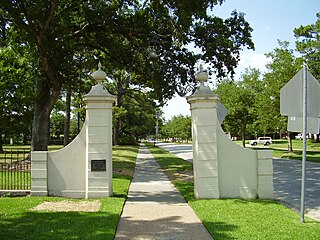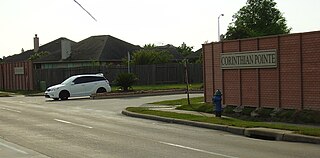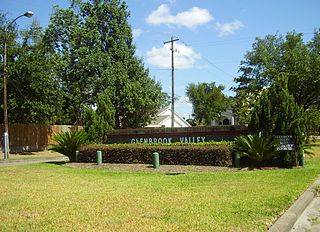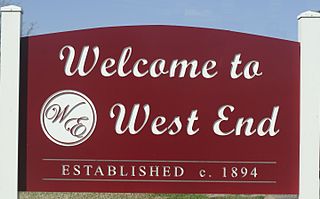
Bellaire is a city in southwestern Harris County, Texas, United States, within the Houston–Sugar Land–Baytown metropolitan area. As of the 2020 U.S. census, the city population was 17,202. It is surrounded by the cities of Houston and West University Place. Bellaire is known as the "City of Homes", owing to its mostly residential character; but it has offices along the I-610 Loop within the city limits.

Hunters Creek Village is a city in Harris County, Texas, United States, part of the Greater Houston metropolitan area. The population was 4,385 at the 2020 census. It is part of a collection of upscale residential communities in west Houston known as the Memorial Villages.

River Oaks is a residential community located in the center of Houston, Texas, United States. Located within the 610 Loop and between Downtown and Uptown, the community spans 1,100 acres (450 ha). Established in the 1920s by brothers Will Hogg and Michael Hogg, the community became a well-publicized national model for community planning. Real estate values in the community range from $1 million to over $20 million. River Oaks was also named the most expensive neighborhood in Houston in 2013. The community is home to River Oaks Country Club, which includes a golf course designed by architect Donald Ross and redesigned in 2015 by Tom Fazio.

River Oaks Elementary School is a magnet school, and neighborhood school, part of the Houston Independent School District. It is located in the River Oaks neighborhood of Houston, Texas, United States As of 2022, Brett Gallini is the principal.

Westside High School is a secondary school in Houston, Texas, United States. It serves grades 9 through 12 and is part of the Houston Independent School District.

Margaret Long Wisdom High School, formerly Robert E. Lee High School, is a publicly funded secondary school located in Southwest Houston, Texas, United States 77057. The Houston Independent School District, the 7th largest school district in the United States, operates Wisdom, a public admission school that enrolls grades 9 through 12. The school serves the neighborhoods of Uptown, Briargrove, Westchase, and Gulfton areas of the city of Houston. Houston Independent School District will submit construction documents in 2016–2017 school year. After the construction documents are submitted, They will vote to seek approval for the new school.

Southampton Place, also known as Southampton, is a neighborhood located in Houston, Texas. The Southampton Civic Club Inc. is the homeowners' association.

Rice Military is a neighborhood in Houston, Texas, United States. The Beer Can House is located in Rice Military.

Briargrove is a neighborhood in Houston, Texas, United States, near Uptown Houston.

St. George Place is a neighborhood in Houston, Texas, United States.

Corinthian Pointe is a large planned affordable subdivision located in Houston, Texas, in the United States. It is a part of the larger master planned community Pointe 2.3.4, and is within the 5 Corners District.

Glenbrook Valley is a subdivision located in Houston, Texas, United States.
Crestwood/Glen Cove is a community in Houston, Texas. It consists of the Crestwood and Glen Cove subdivisions. The Crestwood/Glen Cove Civic Club serves the Crestwood/Glen Cove community.

West End is a neighborhood in Houston, Texas, United States located along the Washington Avenue Corridor.
Southcrest is a community in southeastern Houston, Texas. It is bordered by the 610 Loop, Martin Luther King Boulevard, Bellfort Boulevard, and Mykawa Road.
West Oaks is a small subdivision in Houston, Texas. It is east of, and in close proximity to, Tanglewood proper. Mimi Swartz of National Geographic wrote that compared to River Oaks, West Oaks is "more nondescript". Beginning in the 1990s, George H. W. Bush became a resident of the neighborhood.
Cottage Grove is a community in Houston, Texas.

Ella J. Baker Montessori School, formerly Woodrow Wilson Montessori School and Woodrow Wilson Elementary School, is a public K-8 Montessori school in the Cherryhurst Addition subdivision in the Neartown area of Houston, Texas. A part of the Houston Independent School District (HISD), Baker serves as the neighborhood elementary school for a section of Neartown, including a portion of Montrose. It also serves as a magnet school for all of HISD's territory. As of 2014 it is one of three public Montessori programs in Houston. It was the first HISD school to use the Montessori style for all students, as well as housing HISD's first Montessori middle school program.

















